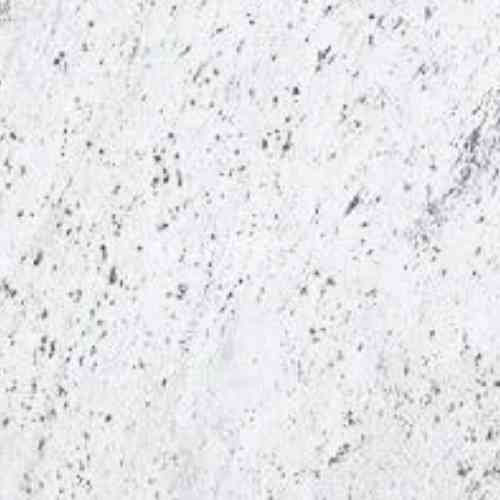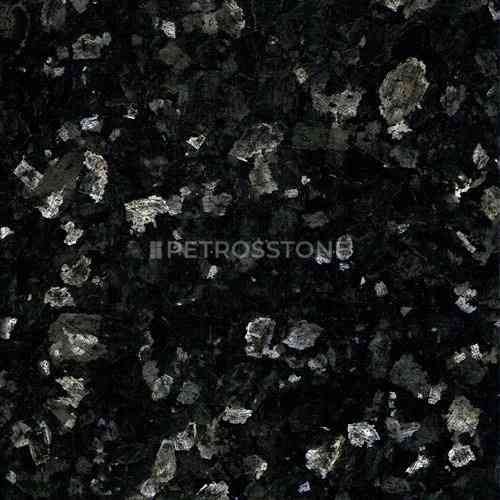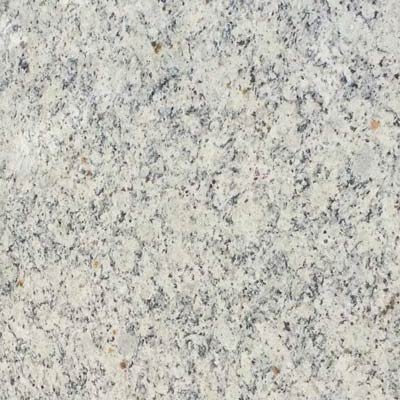
Faux marble, often called artificial or cultured marble, is a collective term that includdes all types of artificial marble that are not mined from the earth. So, faux marbles includes a variety of ways in which natural marble can be replicated. This includes:
- Painted Faux Marble – which usually involved painting a marble like pattern using epoxies and pigments,
- Engineered Faux Marble – marble blocks are manufacutring using marble dust and resins, and then cut into tihin slabs and polished
- Laminated Faux Marble – a marble pattern is printed on a surface and then protectued using plastic or other such materials.
Faux Marble has become a popular choice for interior design and construction due to its aesthetic appeal and affordability. This man-made material mimics the appearance of natural marble and also offers several practical advantages. In this article, we will explore what faux marble is, its composition, manufacturing process, benefits, drawbacks, and its applications in various settings.
- Types of Faux Marble
- Features of Faux Marble
- Characteristics of Faux Marble
- What is Faux Marble Made of? Composition of Faux Marble:
- Manufacturing Process of Faux Marble
- Pros of Faux Marble
- Cons of Faux Marble
- Applications of Faux Marble
- How to Maintain Faux Marble
- Faux Marble vs. Other Alternatives:
- Faux Marble vs. Real Marble :
- Other Alternatives of Faux Marble
- Faux Marble vs. Quartz:
- Faux Marble vs. Natural Marble vs. Quartz
- What is Cultured Marble?
- What is Faux Marble Made Of?
- What is Faux Marble Good For?
- Faux Marble Alternatives
- Faux Marble, Cultured Marble or Natural Marble – Which one to choose?
- Frequently Asked Questions
Types of Faux Marble
Faux marble can be categorized into different types based on its manufacturing technique:
1. Painted Faux Marble
- This method involves using paint techniques to create the illusion of marble on surfaces such as walls or furniture.
- Artists use brushes and sponges to mimic the veining patterns found in natural stone.

2. Engineered Marble
- Engineered marble is often confused with faux marble but differs significantly.
- It consists mainly of crushed natural stone mixed with resins but retains some characteristics of real marble.
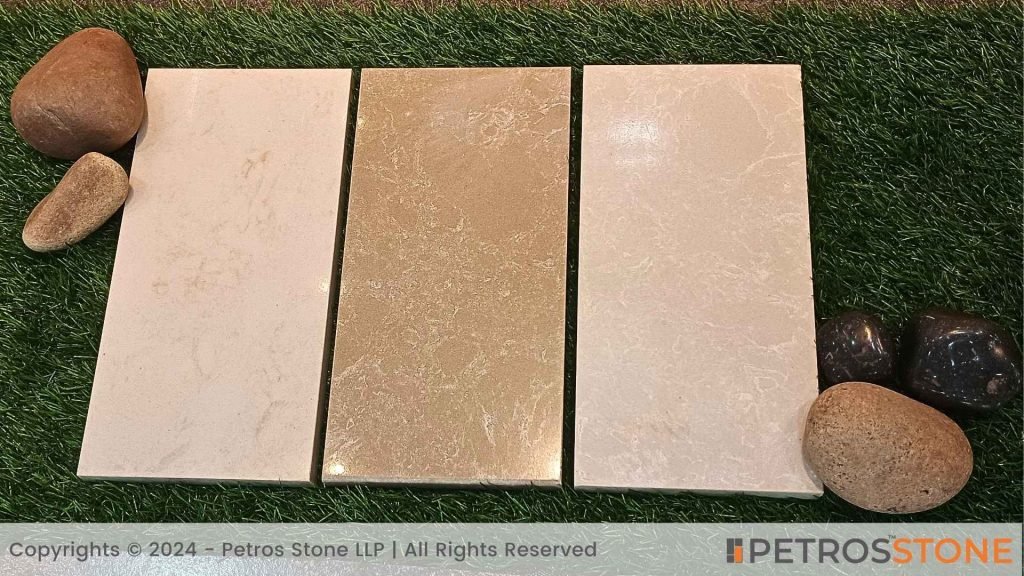
3. Laminated Faux Marble
- Laminated surfaces use a printed design that resembles marble applied over a substrate material.
- This option is commonly used for countertops and cabinetry.
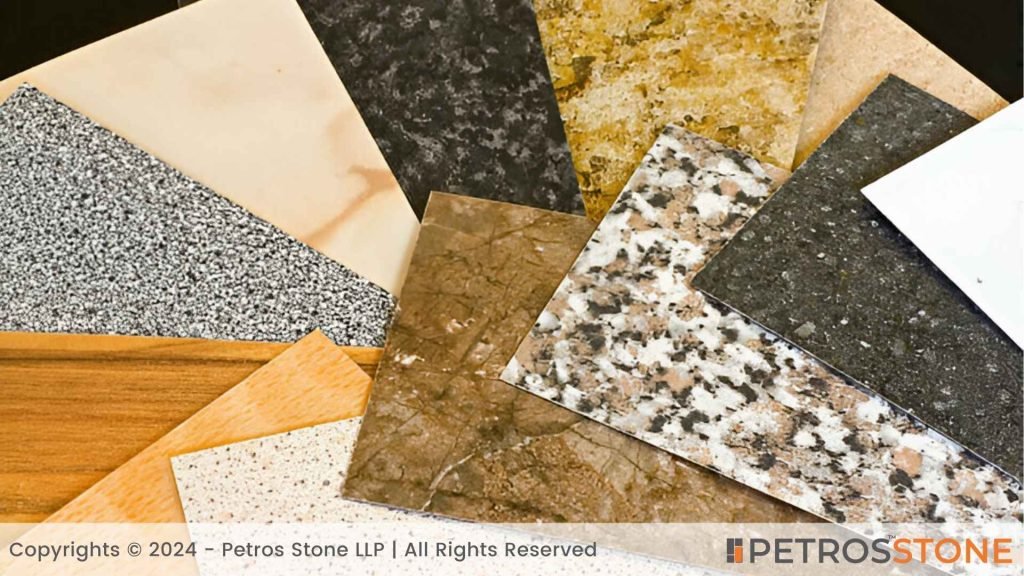
Features of Faux Marble
Faux marble is designed to replicate the look of natural marble through a combination of various materials and techniques. Unlike real marble, which is a metamorphic rock formed under geological conditions, faux marble is a synthetic product created to provide a similar look at a much lower cost.
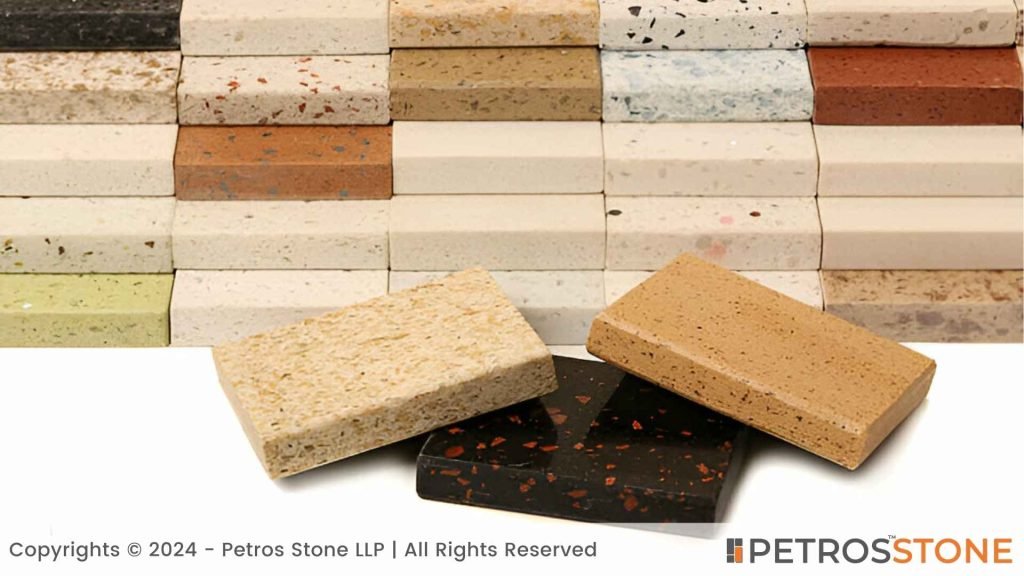
Characteristics of Faux Marble
Appearance:
- Faux marble can closely imitate the veining and color variations found in natural marble.
- It is available in a wide range of colors and patterns which allows customization in design.
Durability:
- While it is not as hard as natural marble, faux marble offers sufficient durability for many applications, making it suitable for countertops, flooring, and decorative elements.
Cost-Effectiveness:
- Faux marble is generally less expensive than natural marble. Thus it is an attractive option for budget-conscious homeowners and designers.
What is Faux Marble Made of? Composition of Faux Marble:
Faux marble is typically made from a mixture of several materials that contribute to its appearance and functionality:
- Marble Dust: Small particles of crushed marble are often included to give the surface a more authentic look.
- Resins: Synthetic resins are used to bind the materials together and provide strength and durability.
- Pigments: Various pigments are added to achieve the desired color and pattern.
- Other Additives: Depending on the manufacturer, additional materials like acrylics or polymers can be included to enhance performance.
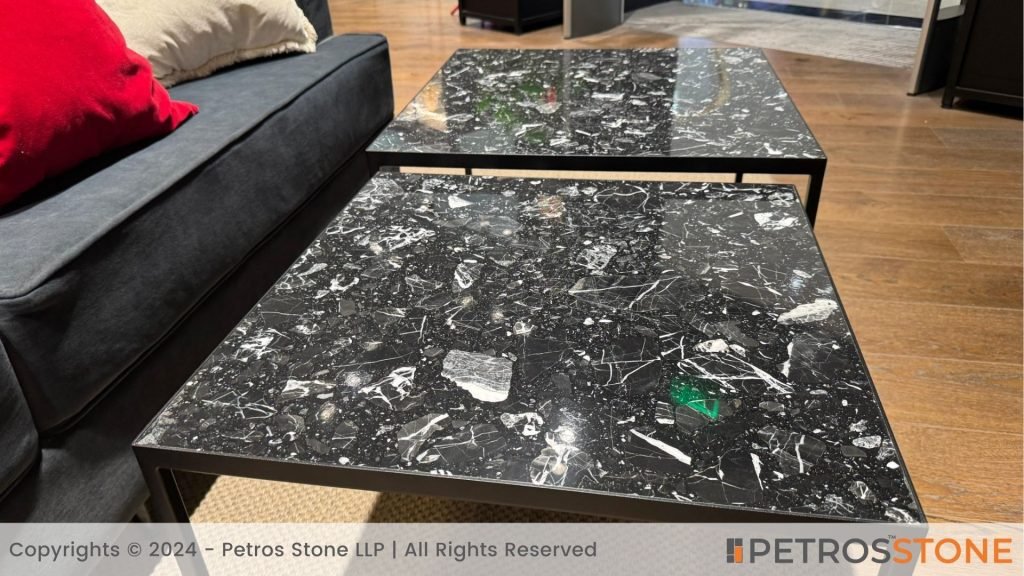
Manufacturing Process of Faux Marble
The process of creating faux marble involves several steps:
Mixing:
The raw materials—marble dust, resins, pigments—are mixed together in predetermined ratios to achieve the desired consistency and color.
Molding:
The mixture is poured into molds that further shape it into slabs or tiles or even blocks

Curing:
The molded material is cured under specific conditions to ensure it hardens properly.
Finishing:
Once cured, the faux marble surface is polished or treated with a gel coat to enhance its shine and durability.
Pros of Faux Marble
Faux marble offers several advantages that make it an appealing choice for many applications:
Affordability:
One of the most significant benefits of faux marble is its cost-effectiveness compared to natural stone.
Variety:
With numerous colors and patterns available, homeowners can easily find a faux marble option that suits their aesthetic preferences.
Lightweight:
Faux marble products are generally lighter than their natural counterparts, making them easier to handle and install.
Non-Porous Surface:
Many faux marbles have a non-porous surface due to their resin content which makes them resistant to stains and easy to clean.
Customization:
Buyers can choose specific colors and patterns during the manufacturing process, this allows greater design flexibility.
Cons of Faux Marble
Despite its many benefits, faux marble also has some drawbacks:
Less Authenticity:
While faux marble can closely resemble real stone, some people may find it lacks the unique character that comes with natural variations in genuine marble.
Durability Concerns:
Although durable for many applications, faux marble may not withstand heavy impact or extreme heat equivalent to natural stone.
Potential for Scratching:
The surface may be more prone to scratches compared to harder materials like granite or true marble.
Limited Lifespan:
Depending on usage and care, faux marble may not last as long as natural stone surfaces.
Applications of Faux Marble
Faux marble can be used in various settings due to its versatility:
1. Countertops
Faux marble countertops are popular in kitchens and bathrooms because they offer an elegant look without the high price tag associated with natural stone.
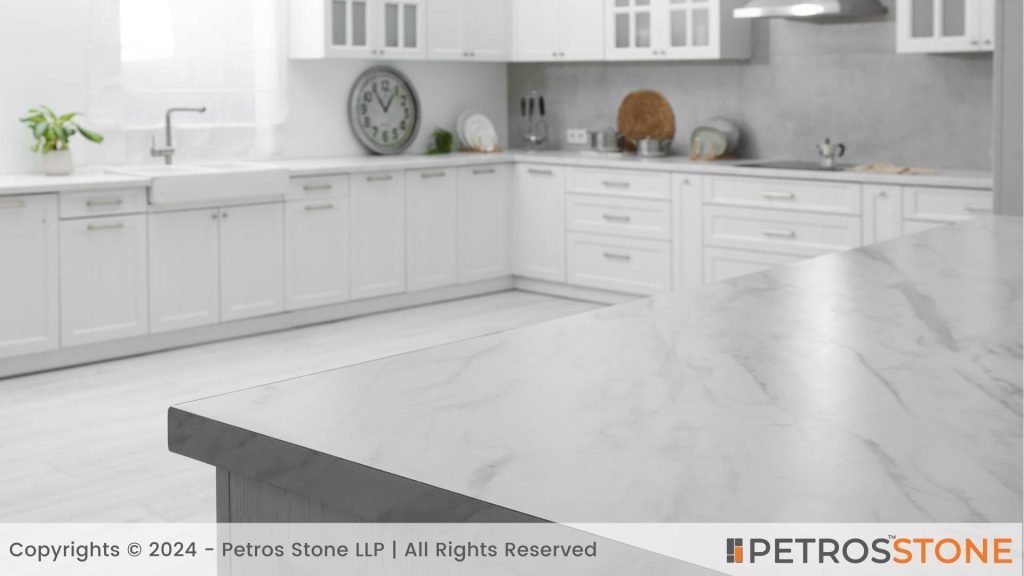
2. Flooring
Faux marble tiles can be installed in both residential and commercial spaces, providing a sophisticated appearance while being easier to maintain than real stone.
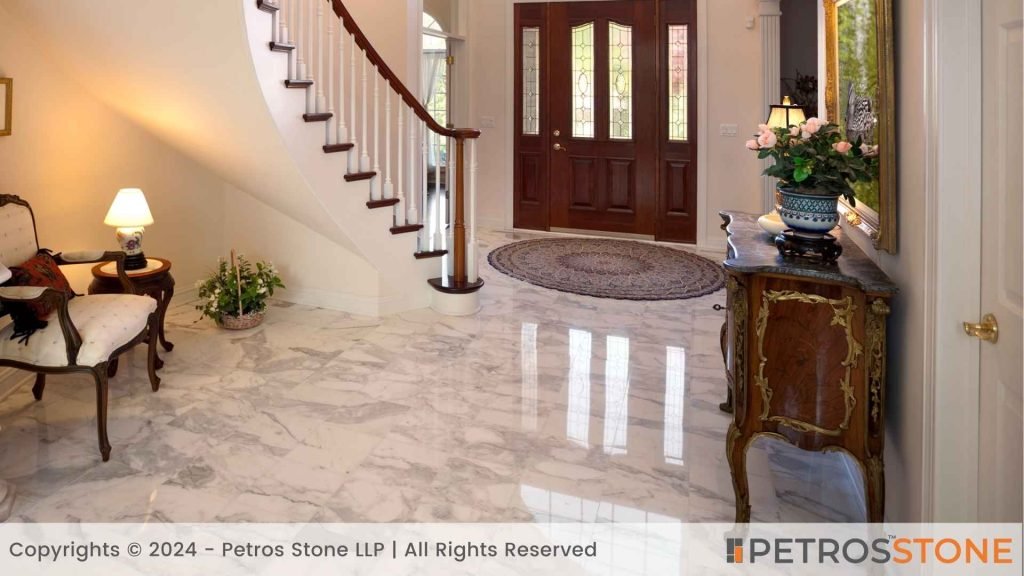
3. Wall Treatments
Faux marbling techniques can be applied on walls for decorative purposes, creating an upscale ambiance without the costs associated with real stone.
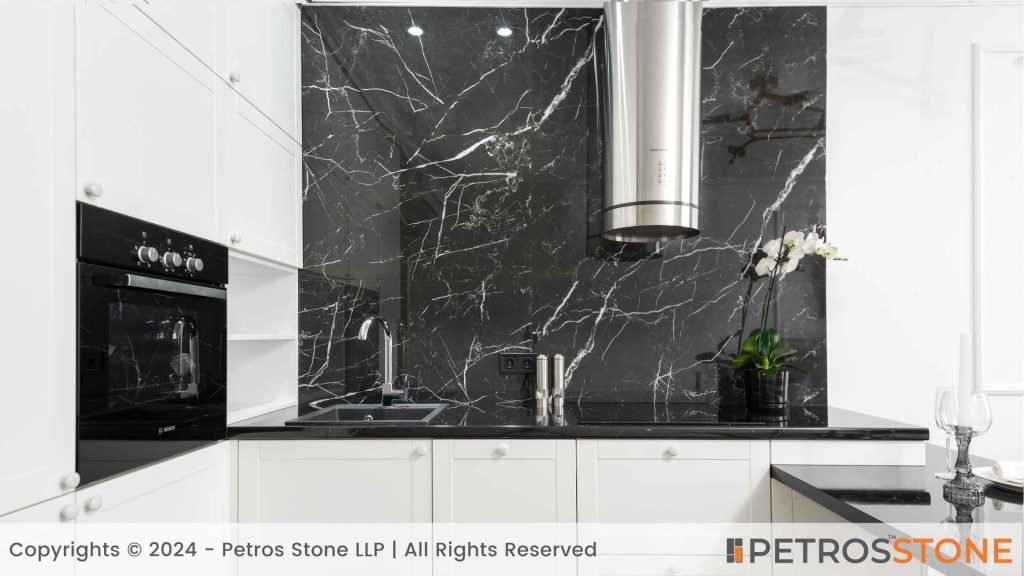
4. Furniture
Many furniture pieces do feature faux marble finishes thus allowing homeowners to incorporate this luxurious look into their decor without significant expense.

5. Pillar
Faux marble pillars offer the elegance of authentic marble without the weight, structural risks, or exorbitant costs associated with the real material.

4. Sculptures and Decorative Pieces
Bring timeless artistry and refined elegance to any space, enhancing its charm and aesthetic appeal.
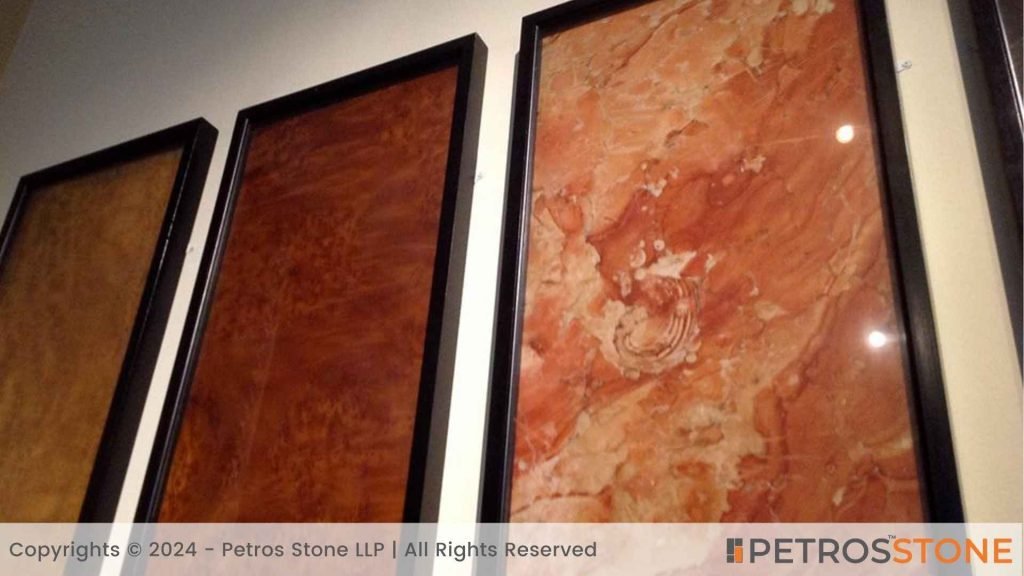
How to Maintain Faux Marble
To maintain the appearance and longevity of faux marble surfaces, follow the mentioned tips:
Regular Cleaning: Use mild soap and water for routine cleaning; avoid harsh chemicals that could damage the surface.
Avoid Abrasives: Do not use abrasive cleaners or pads that could scratch the surface.
Sealing (if applicable): Some faux marbles may benefit from periodic sealing; check manufacturer recommendations.
Faux Marble vs. Other Alternatives:
When it comes to choosing materials for home decor, particularly for surfaces like countertops, flooring, and furniture, marble is often at the top of the list.
However, homeowners face a choice between faux marble and the other alternatives available in the market. Each option has its own set of pros and cons that can significantly impact both aesthetic appeal and practical use.
Faux Marble vs. Real Marble :
What is Real Marble?
Real marble is a natural stone that is known for its beauty and durability. Formed from limestone under high pressure and temperature, marble is known for its unique veining patterns and colors, which are influenced by the minerals present during its formation.
Pros of Real Marble
- Aesthetic Appeal: Each piece of natural marble is unique, and offers distinct patterns and colors that cannot be replicated.
- Durability: Marble is a strong material that can withstand heat and pressure, making it suitable for various applications.
- Value Addition: Homes with real marble surfaces often see an increase in property value due to the luxurious appeal of natural stone.
Cons of Real Marble
- Porosity: Marble is porous, which makes it susceptible to staining from spills if not properly sealed.
- Maintenance: It requires regular sealing and maintenance to prevent damage from acidic substances like lemon juice or vinegar.
- Cost: Natural marble can be quite expensive due to quarrying, cutting, and installation processes.
Applications of Real Marble
Real marble is a metamorphic rock formed from limestone under intense heat and pressure, resulting in a unique and beautiful stone with various colors and veining patterns. It has numerous applications:
1. Countertops
- Marble countertops are a popular choice in kitchens and bathrooms due to their aesthetic appeal.
- They provide a luxurious look while being suitable for food preparation, although they require regular sealing to prevent staining.
2. Flooring
- Marble flooring adds elegance and sophistication to any room.
- It is durable enough to withstand foot traffic while providing a timeless appeal that enhances the overall decor.
3. Wall Cladding
- Using marble for wall cladding can create stunning feature walls in living rooms, dining areas, or even exteriors.
- The unique patterns and colors of marble can transform a plain wall into a work of art.
4. Sculptures and Decorative Pieces
- Marble has been used for centuries in sculpture due to its aesthetic qualities.
5. Fireplaces
- Marble is an excellent choice for fireplace surroundings due to its heat resistance and ability to add a luxurious touch to living spaces.
6. Stairs and Staircases
- Marble staircases not only enhance the beauty of homes but also provide durability and safety when properly finished.
7. Bathrooms
- From vanity tops to shower walls, marble is frequently used in bathrooms for its elegant appearance and water resistance when sealed properly.
8. Furniture
- Custom furniture pieces such as coffee tables or side tables made from marble serve as statement pieces that elevate interior design.
Faux Marble vs. Real Marble:
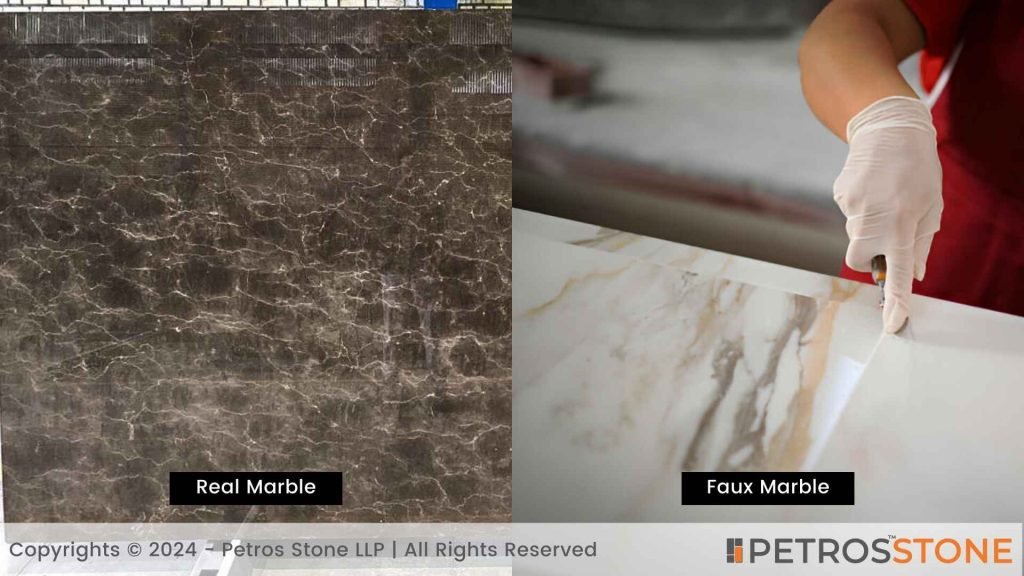
| Feature | Faux Marble | Real Marble |
|---|---|---|
| Composition | Made from synthetic materials (resins, acrylics) | Natural stone formed from limestone |
| Appearance | Mimics marble but lacks natural veining | Unique veining and color variations |
| Durability | Less durable; prone to scratches and heat damage | Durable but softer than granite; can chip or scratch |
| Maintenance | Low maintenance; no sealing required | Requires regular sealing and careful cleaning |
| Cost | Generally more affordable ($20 – $50 per sq. ft.) | More expensive ($40 – $100 per sq. ft.) |
| Weight | Lighter than real marble | Heavier; requires proper installation |
| Heat Resistance | Moderate; can be damaged by high heat | Moderate; sensitive to high temperatures |
Cost Comparison: Real Marble vs. Faux Marble
When considering marble for your project, cost is often a significant factor. Here’s how the cost of real marble compares to faux marble:
Cost of Real Marble
The price of real marble can vary widely based on factors such as type, quality, sourcing location, and installation costs. On average:
- Cost per Square Foot: Real marble typically ranges from $40 to $100 per square foot.
- Installation Costs: Installation can add an additional $10 to $30 per square foot, depending on complexity and labor rates.
Cost of Faux Marble
Faux marble is generally more affordable than natural stone:
- Cost per Square Foot: Faux marble usually ranges from $5 to $20 per square foot.
- Installation Costs: Installation costs for faux marble are often lower due to its lightweight nature and ease of handling, typically around $5 to $15 per square foot.
Cost Comparison Table
| Feature | Faux Marble ($/sqft) | Real Marble ($/sqft) |
|---|---|---|
| Cost of Materials | $5 – $20 | $40 – $100 |
| Installation Charges | $5 – $15 | $10 – $30 |
| Total Cost | $35 – $85 | $50 – $130 |
Other Alternatives of Faux Marble
The other alternative of faux marble are as follows:
Quartz: Engineered stone made from crushed quartz mixed with resins; it offers durability similar to faux marble but with an even broader range of colors and patterns.
Granite: A natural stone that is harder than both faux and real marble; it provides excellent durability and resistance to heat.
Solid Surface Materials: These are acrylic-based products that can mimic the look of stone while offering seamless designs and easy maintenance.
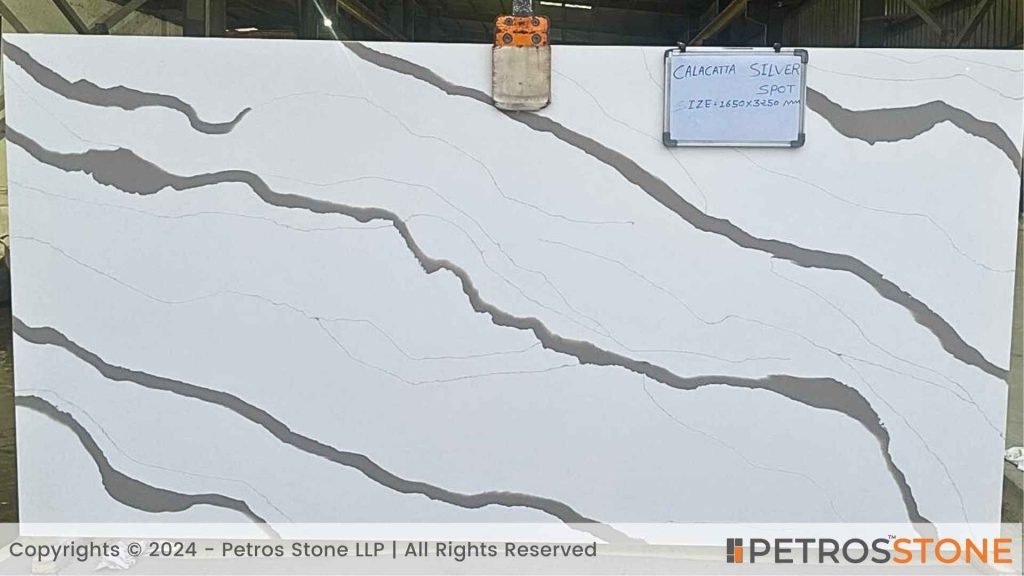
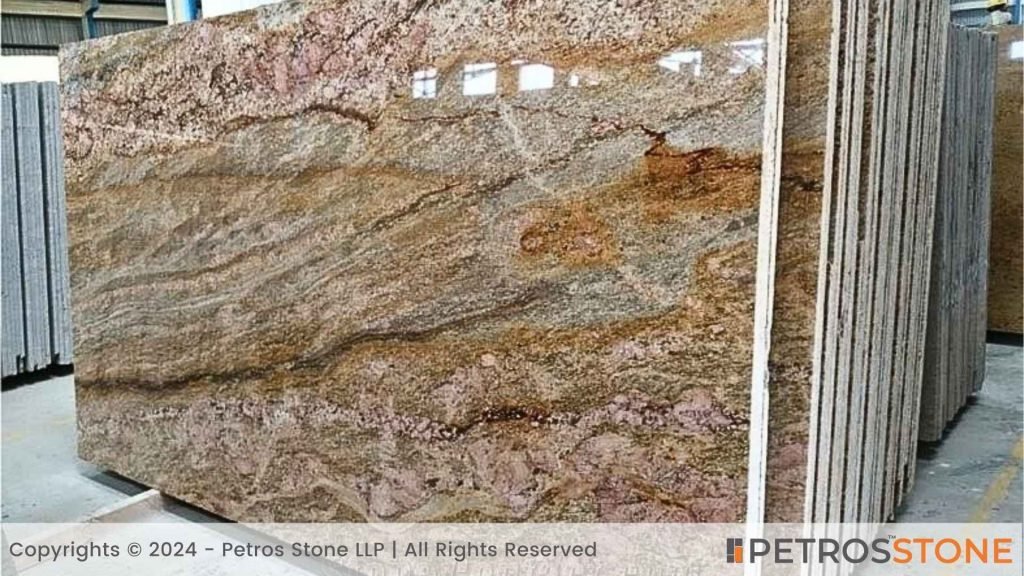

Faux Marble vs. Quartz:
What is Quartz?
Quartz countertops are engineered surfaces made from approximately 90% crushed natural quartz crystals mixed with resins and pigments. This combination results in a non-porous material that is known for its durability and wide range of design options.
Characteristics of Quartz
- Durability: Quartz is one of the hardest materials available for countertops, making it resistant to scratches, chips, and cracks.
- Non-Porous: Unlike natural stone, quartz does not require sealing, as it is resistant to stains and bacteria.
- Variety of Designs: Available in a wide array of colors and patterns, quartz can mimic the look of natural stones like granite or marble while providing a consistent appearance.
Pros of Quartz
Exceptional Durability: Quartz is highly resistant to scratches, chips, and heat.
Low Maintenance: Does not require sealing or special care; easy to clean with soap and water.
Consistent Appearance: Offers a uniform look throughout the surface without the variations found in natural stones.
Cons of Quartz
Cost: Generally more expensive than faux marble but often less expensive than high-end natural stones.
Artificial Look: Some people find quartz’s uniformity less appealing compared to the unique patterns of real marble.
Heat Sensitivity: While durable, quartz can scorch or crack under extreme heat.
Faux Marble vs. Quartz
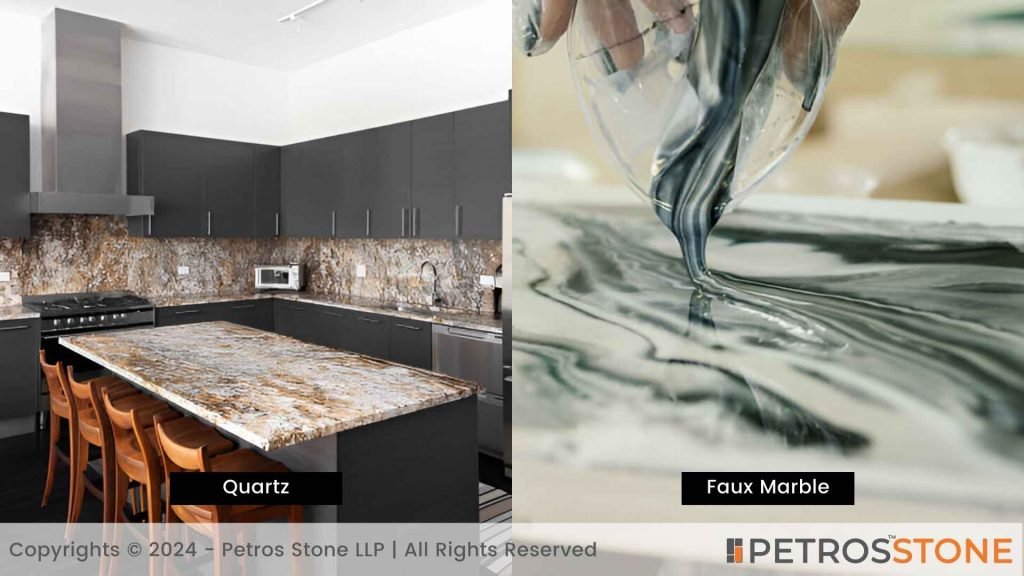
| Feature | Faux Marble | Quartz |
|---|---|---|
| Composition | Made from synthetic materials (resins, acrylics) | Engineered from approximately 90% crushed natural quartz mixed with resins |
| Appearance | Mimics marble but lacks unique veining | Offers a wide range of colors and patterns; can mimic natural stones but has a more uniform look |
| Durability | Generally less durable; may scratch or chip easily | Highly durable; resistant to scratches, chips, and stains |
| Maintenance | Low maintenance; does not require sealing | Very low maintenance; does not require sealing or special care |
| Cost | Typically more affordable ($20 – $50 per sq. ft.) | Generally more expensive ($50 – $150 per sq. ft.) |
| Weight | Lighter and easier to handle | Heavier; requires sturdy support |
| Heat Resistance | Moderate; can be damaged by high heat | Moderate; can scorch or crack under extreme heat |
Applications of Quartz
Quartz has become increasingly popular for a wide range of applications due to its durability and low maintenance:
Countertops: Widely used in kitchens and bathrooms due to its resistance to stains and scratches.
Backsplashes: Offers a seamless look that complements countertops while being easy to clean.
Flooring: Durable enough for high-traffic areas while maintaining an elegant appearance.
Commercial Spaces: Often used in restaurants and offices where durability and aesthetics are essential.
Cost Comparison of Faux Marble and Quartz
When considering budget constraints, it’s essential to compare the costs associated with each material:
Faux Marble: Typically ranges from $30 to $50 per square foot depending on quality and design complexity.
Quartz: Generally falls between $50 to $150 per square foot based on brand and design choices.
While faux marble offers an economical alternative, quartz provides long-term value through its durability and low maintenance requirements.
Faux Marble vs. Natural Marble vs. Quartz
When comparing these three materials—faux marble, natural marble, and quartz—several factors come into play:
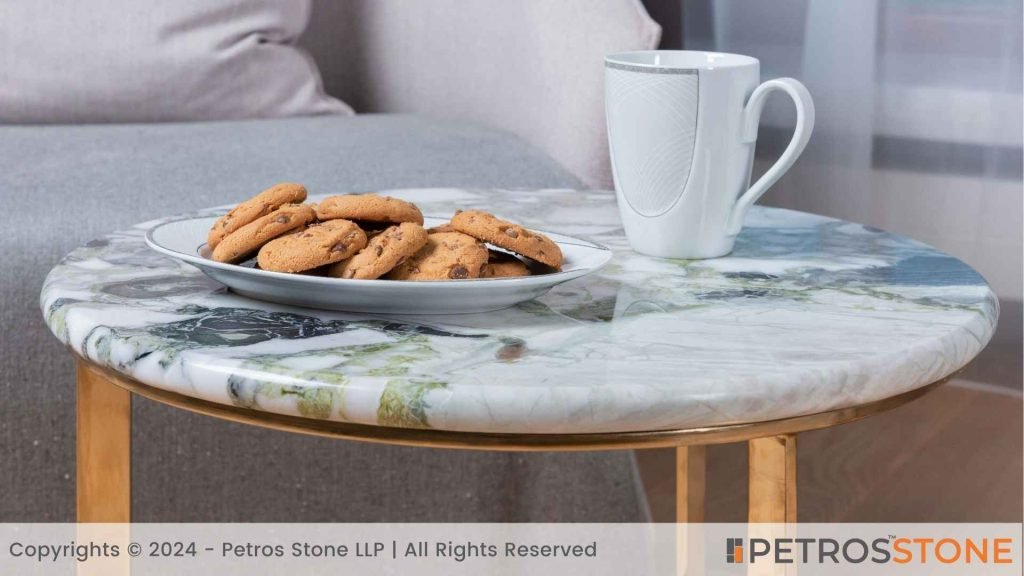


| Feature | Faux Marble | Natural Marble | Quartz |
|---|---|---|---|
| Cost | Generally lower | Higher due to quarrying | Mid-range; less than natural marble |
| Durability | Good; resistant to scratches | Moderate; porous | Excellent; non-porous |
| Maintenance | Low; no sealing required | High; requires regular sealing | Low; easy cleaning |
| Heat Resistance | Moderate; can burn/melt | High; withstands high temperatures | Moderate; some brands are heat resistant |
| Aesthetic Appeal | Good imitation but less unique | Unique veining and colors | Wide variety but lacks natural look |
What is Cultured Marble?
Cultured marble is a specific type of faux marble that combines real marble dust with synthetic resins and pigments to create a man-made product that resembles natural marble. It is often used for countertops, sinks, and bathroom fixtures.
Composition of Cultured Marble
- Marble Dust: Typically composed of 75-80% crushed natural marble particles.
- Resins: Synthetic resins bind the marble dust together and provide strength.
- Pigments: Added to create various colors and patterns that mimic natural stone.
Characteristics of Cultured Marble
- Integrated Design: Cultured marble products often feature integrated sinks and backsplashes, creating a seamless look.
- Non-Porous Surface: Unlike natural marble, cultured marble does not require sealing due to its non-porous nature.
- Variety of Styles: Available in numerous colors and patterns, allowing for customization in design.
Pros of Cultured Marble
- Seamless Design: Integrated sinks and backsplashes create a cohesive look without visible seams.
- Low Maintenance: Non-porous surface requires minimal upkeep compared to natural stone.
- Durability: Resistant to stains and easy to clean.
Cons of Cultured Marble:
- Less Unique: While cultured marble can mimic real stone, it lacks the unique character found in natural slabs.
- Potential for Damage: Although durable, it can chip or scratch if subjected to heavy impacts or heat.
- Perceived Value: Some may view cultured marble as less luxurious compared to natural stone.
Applications of Cultured Marble
Cultured marble is versatile and can be used in various areas of the home. Here are some common applications:
1. Bathroom Vanities
- Cultured marble is often used for bathroom vanity tops due to its elegant appearance and durability.
- The non-porous surface resists stains and moisture, making it ideal for high-humidity environments.
2. Showers and Bathtubs
- Cultured marble is frequently used in shower surrounds and bathtub enclosures.
- It can be molded to fit specific dimensions, reducing the need for grout lines, which makes cleaning easier.
- Additionally, it can be used for shower pans, providing a waterproof surface that enhances the aesthetic appeal of the bathing area.
3. Backsplashes
- In both kitchens and bathrooms, cultured marble serves as an excellent backsplash material.
- Its waterproof nature makes it easy to clean and maintain while providing a luxurious look.
4. Sinks
- Cultured marble can be cast into virtually any shape or size, allowing for integrated sinks without seams.
- This seamless design not only looks sleek but also simplifies cleaning.
5. Flooring
- With its durability and attractive appearance, cultured marble can also be used as flooring in bathrooms or entryways.
- Its non-porous surface helps prevent moisture-related issues.
6. Decorative Elements
- Cultured marble can be used for decorative features such as window sills, shelves, and even furniture accents.
- Its ability to be customized in terms of color and design makes it a flexible option for interior decor.
Faux Marble vs. Cultured Marble
| Feature | Faux Marble | Cultured Marble |
|---|---|---|
| Composition | Various synthetic materials | 75-80% marble dust mixed with resins |
| Appearance | Can vary widely; may not be realistic | Designed to closely mimic real marble |
| Durability | Varies based on materials used | Generally durable; resistant to stains |
| Cost | Typically lower | More affordable than real marble |
| Maintenance | May require special care | Low maintenance; no sealing needed |
Cost Comparison: Cultured Marble vs. Faux Marble
When considering materials for your renovation project, cost is often a significant factor. Here’s how cultured marble compares to faux marble:
Cost of Cultured Marble
The price of cultured marble can vary based on factors such as quality, design complexity, and installation requirements:
- Cost per Square Foot: Cultured marble typically ranges from $30 to $60 per square foot.
- Installation Costs: Installation costs usually add an additional $5 to $15 per square foot.
Cost of Faux Marble
Faux marble is generally more affordable than both natural marble and cultured options:
- Cost per Square Foot: Faux marble usually ranges from $20 to $50 per square foot.
- Installation Costs: Installation costs for faux marble are often lower due to its lightweight nature, typically around $5 to $10 per square foot.
Cost Comparison Table
| Feature | Cultured Marble | Faux Marble |
|---|---|---|
| Cost per Square Foot | $30 – $60 | $20 – $50 |
| Installation Costs | $5 – $15 | $5 – $10 |
| Total Cost Range | $35 – $75 | $25 – $60 |
What is Faux Marble Made Of?
Faux marble can be made from a variety of materials depending on the desired look and application:
Acrylics and Resins: Commonly used in creating faux finishes that resemble stone.
Paint Techniques: Artists can use specialized paint techniques to create faux marbling effects on walls or furniture.
Laminates: Printed designs that imitate the appearance of marble applied over a substrate material for countertops or cabinets.
What is Faux Marble Good For?
Faux marble has a range of applications across different settings:
1. Countertops
- Faux marble countertops provide an elegant look at a fraction of the cost of real stone, making them ideal for kitchen islands or bathroom vanities.
2. Flooring
- Faux marble tiles can enhance the aesthetic appeal of any room while being easier to maintain than traditional stone flooring.
3. Wall Treatments
- Faux marbling techniques can be applied on walls for decorative purposes, creating an upscale ambiance without the costs associated with real stone.
4. Furniture
- Many furniture pieces feature faux marble finishes, allowing homeowners to incorporate this luxurious look into their decor without significant expense.
Faux Marble Alternatives
For those considering faux or cultured options but looking for alternatives, several materials exist:
Quartz: Engineered stone made from crushed quartz mixed with resins; it offers durability similar to cultured marble but with an even broader range of colors and patterns.
Granite: A natural stone that is harder than both faux and cultured marble; it provides excellent durability and resistance to heat.
Faux Marble, Cultured Marble or Natural Marble – Which one to choose?
Choosing between faux marble, cultured marble, or genuine natural stone ultimately depends on individual needs, preferences, and budget considerations. If you are looking for an affordable yet stylish option that requires minimal maintenance, faux marble may be your best bet. Cultivated marble presents an excellent alternative for those who desire a more authentic look with integrated designs like sinks or backsplashes without the high price tag associated with real stone. However, if authenticity and uniqueness are paramount in your design plans, investing in natural stone may be worthwhile despite its higher cost. Understanding these differences makes it easy for homeowners to make decisions about their interior design choices while ensuring they select materials that align with their lifestyle needs and aesthetic preferences.
Faux marble presents an appealing alternative to natural stone for those seeking beauty without breaking the bank. Its versatility in design options and benefits make it suitable for various applications in homes and commercial spaces.
Petros® Stone is a leading provider of high-quality stone products, specializing in a diverse range of materials that can significantly elevate both your residential and commercial spaces. Their extensive product lineup includes granite, marble, quartz, sandstone, limestone, and synthetic options, making them a one-stop solution for your various architectural and design needs.
Frequently Asked Questions
What is faux marble made of?
Faux marble is typically made from a blend of materials designed to replicate the appearance of natural marble. The base is usually a composite material, such as solid surfacing or cultured marble, which is then covered with a gel coating that mimics the veins and patterns found in real stone. This combination gives faux marble its realistic appearance while enhancing its durability and ease of maintenance.
How does faux marble differ from cultured marble?
While both faux marble and cultured marble aim to mimic the look of natural marble, they differ in composition. Cultured marble is made primarily from crushed natural marble mixed with resins, while faux marble can include a variety of synthetic materials and techniques, such as painted laminates or polymer blends. Cultured marble usually has a more authentic look due to its use of real marble dust.
What are the benefits of using faux marble?
Faux marble offers several advantages, including affordability, lightweight nature, and low maintenance requirements. It does not need sealing like natural marble and is resistant to stains and scratches, making it suitable for high-traffic areas.
Can faux marble be used for countertops?
Yes, faux marble is commonly used for countertops in kitchens and bathrooms. Its durable surface can withstand daily use, and it is easier to maintain than natural stone. However, it’s important to note that while it can mimic the appearance of real marble, some may find it lacks the unique character of natural stone.
How do you care for faux marble surfaces?
Caring for faux marble surfaces is relatively simple. Regular cleaning with mild soap and water is sufficient to keep them looking new. Harsh chemicals or abrasive cleaners that could damage the surface should be avoided. Unlike natural marble, faux marble does not require sealing or special treatments, making it a low-maintenance option.
Feel free to get in touch for a free consultation, quote, and get a detailed understanding from our experts here at Petros®. Visit https://petrosstone.com/ or call +91-8446360361 and WhatsApp

Hi!
I’m Ritupriya, and I bring together years of experience in architecture with a deep passion for writing. At Petros® Stone, I share my insights on natural stone, helping readers explore its role in design, durability, and timeless beauty.
Brown Granite
White Galaxy Granite
Blue Bahia Granite
Silver Cloud Granite
Black Pearl Granite
Dallas White Granite


